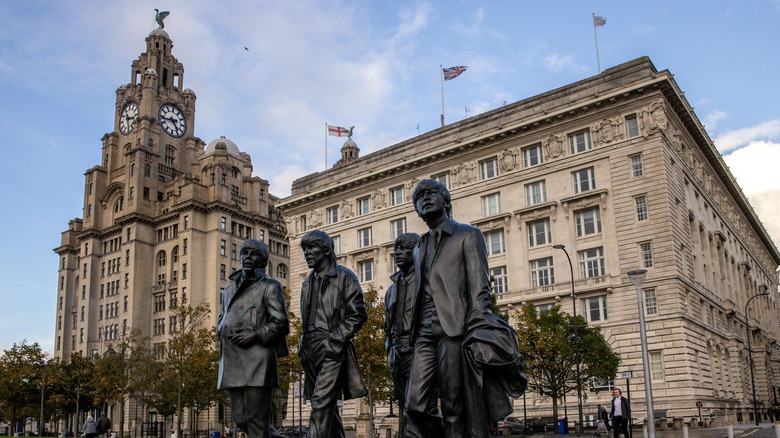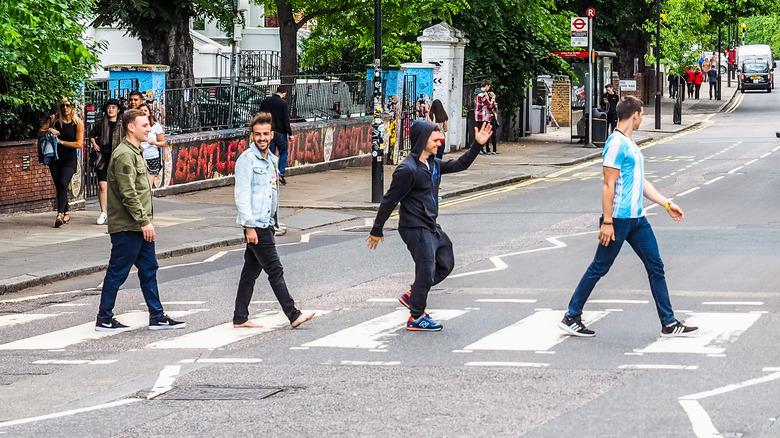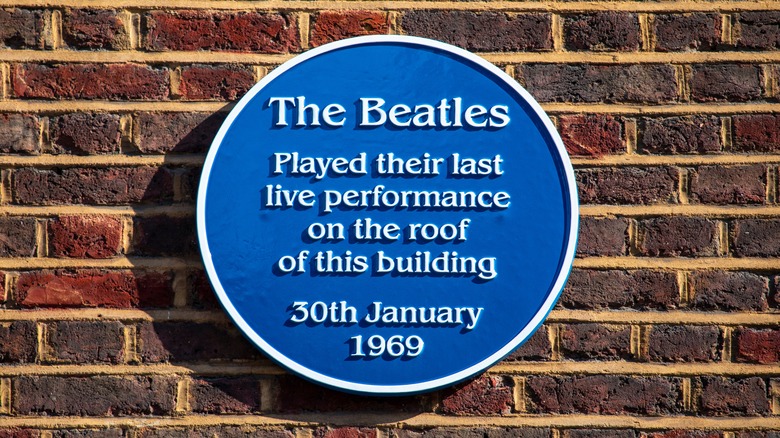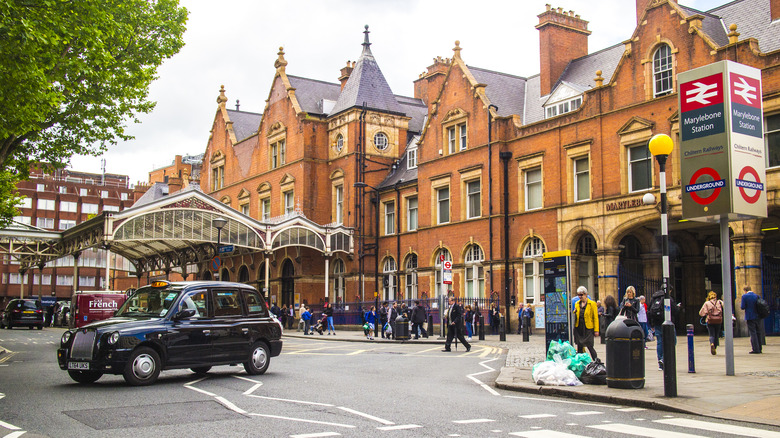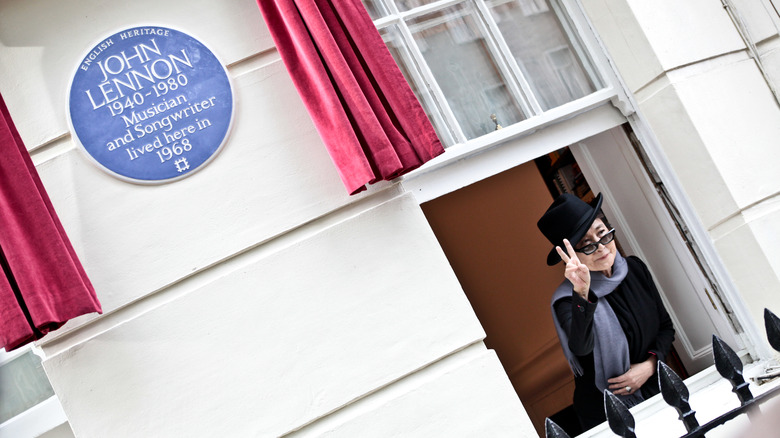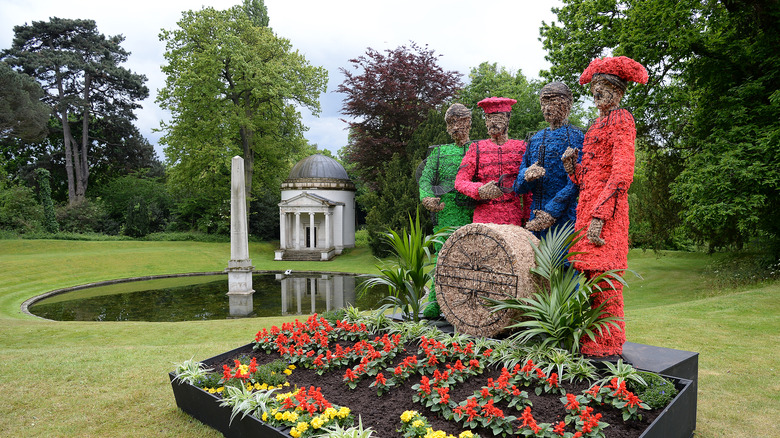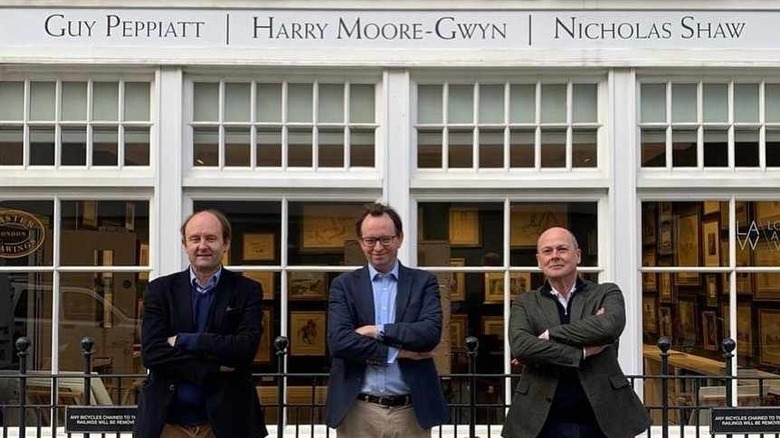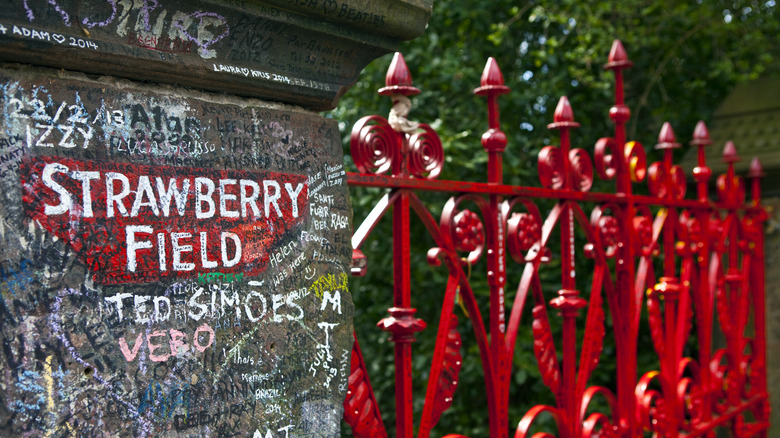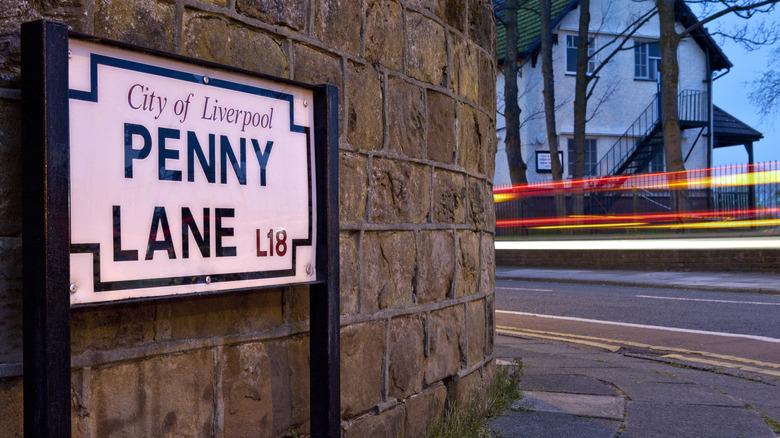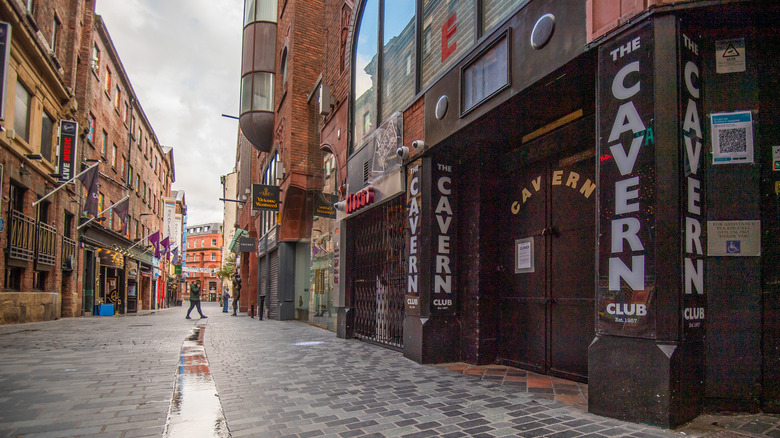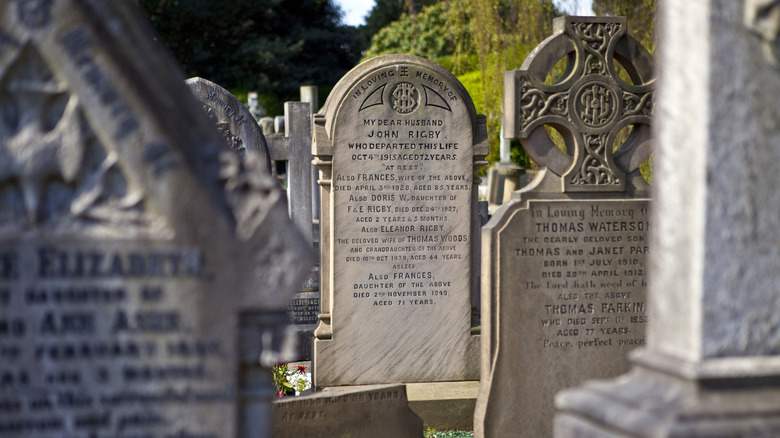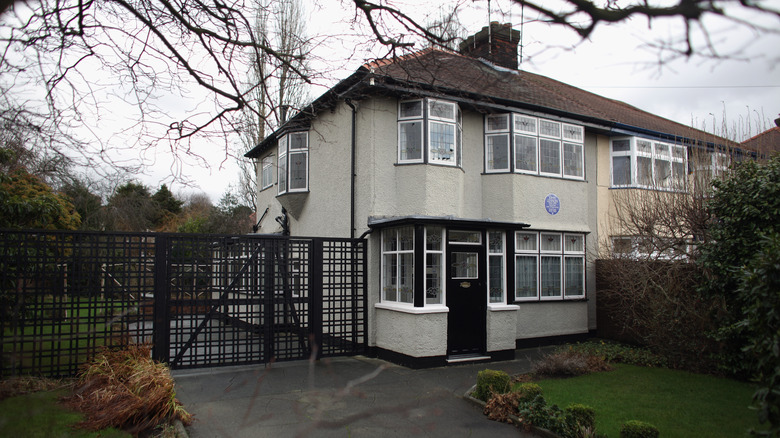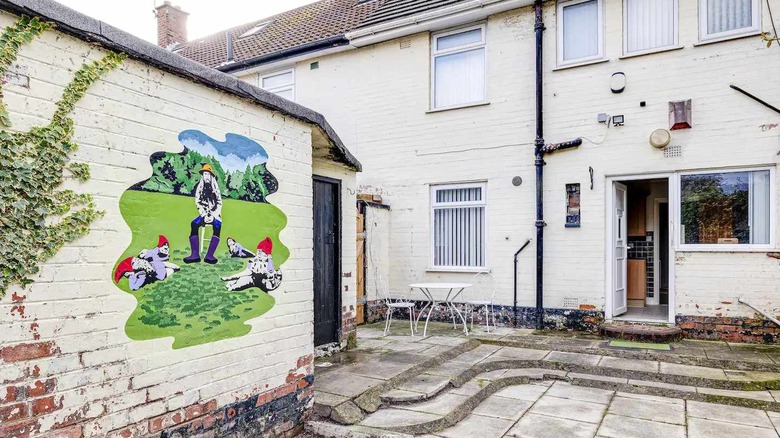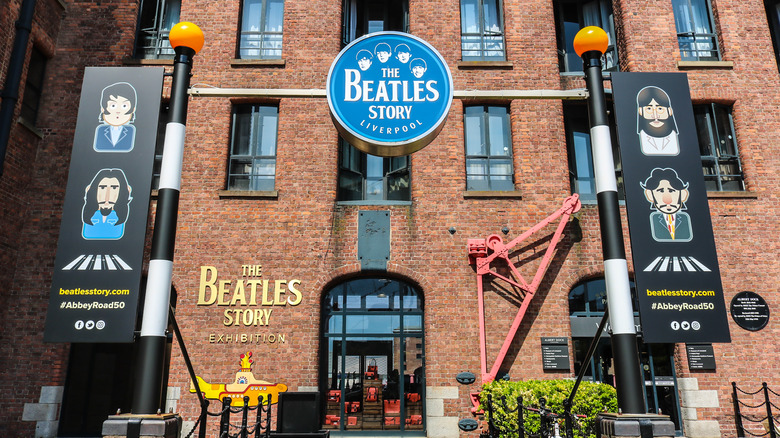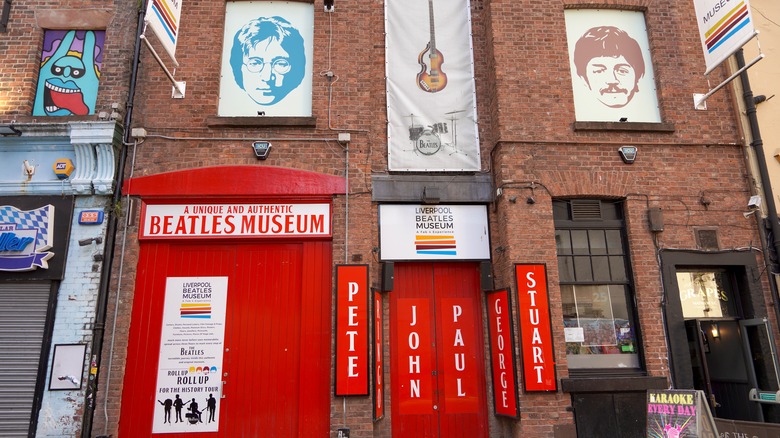The Beatles Lovers' Guide To London And Liverpool
Whether you turned "Sixty-Four" "Yesterday" or were born "Any Time At All" thereafter, it's possible you grew up loving the Beatles or grew to love them. And what's not to love about the fabulous four that hail from Liverpool, England? John Lennon, Paul McCartney, George Harrison, and Ringo Starr rocked the world of music as The Bealtes, and they proved to the world that "All You Need Is Love."
Wherever you hail from, you don't have to hide your love of the Beatles away. Why not "Come Together" and "Get Back" to where John, Paul, George, and Ringo once belonged? You don't need a "Ticket to Ride" to be a "Day Tripper." You can seek out some of The Beatles' points of interest in London with the blue plaques, or head north to Liverpool to spend "A Day in the Life" in the lads' storied past.
While there are many options to explore "Here, There and Everywhere" of Beatlemania in the two cities with a little help from your soon-to-be friends – Beatles London Walks by the great guide Richard Porter, and the Magical Mystery Tour or Fab 4 Taxi Tours – feel free to strike it out on your own, "I, Me, Mine" style. Here are the places any lovers of The Beatles must add to their itinerary, and there's no time like the present to visit them, because, as they said it best, "Tomorrow Never Knows."
Abbey Road
Out of the 210 songs the Beatles recorded between 1962-1970, 190 of them were captured by legendary engineer George Martin in the three-story townhouse built in 1830 that later became EMI Recording Studios in St. John's Wood, London. The last set of recordings that made up their final record was almost titled "Everest," but the group went with the name of the road that runs parallel to the studio — "Abbey Road." Paul McCartney came up with a sketch of the album cover's design, and at 11:35 a.m. on August 8, 1969, John, Paul, George, and Ringo stepped outside and walked the "zebra crossing" away from the studio, while photographer Iain MacMillan snapped six photos atop a ladder.
"Abbey Road" instantly became one of the most iconic album covers of all time, and has since been lovingly parodied by the likes of the Red Hot Chili Peppers, Sesame Street, Benny Hill, Lindsay Lohan, and even McCartney himself, poking fun at the whole "Paul is dead" phenomenon. EMI Studios even renamed itself Abbey Road Studios in 1976 in honor of the landmark album, and also captured the sounds of Pink Floyd, Radiohead, Oasis, Amy Winehouse, Lady Gaga, Adele, and countless movie scores. Both the studios and the pedestrian crossing have been granted landmarked status by the English government.
Abbey Road welcomes you to recreate the album cover at the busy crossing (always a fun watch on the webcam), pen a message on the graffiti wall, and of course, stop by their gift shop.
Former Apple Corps HQ at 3 Savile Road
Looking to avoid paying the "Taxman" millions, the Beatles' financial advisors suggested they channel some of their funds into a business venture. Apple Corps was formed in 1967 as a holding company, with subsidiaries for music, film, publishing, electronics, and other ventures. They first had temporary offices at 94 Baker Street (not far from Sherlock Holmes at 221b), and on the ground floor, a mod Apple fashion boutique that didn't even last a year.
Apple HQ moved briefly to 95 Wigmore Street (though the building no longer exists), and then on to 3 Savile Row, as Paul McCartney told author Barry Miles that it was "a good London building," and once "Lady Hamilton's London residence, which [Lord Horatio] Nelson bought for her." Built in the 1730s, the Beatles made good use of the property from the ground up. Beatles, friends, Apple employees, label signees, reporters, groupies, and even Hell's Angels hung about the offices, and the basement housed a recording studio where the album that later became known as "Let it Be" would be polished, and the roof, where the group last performed together live, at lunchtime on January 30, 1969.
The Beatles sold off 3 Savile Row in 1976, but that hasn't stopped "Apple Scruffs" (aka their most rabid fans) from stopping by to pay their respects to this day.
Marylebone Station
Beatlemania hysteria was recreated in the hit 1964 Dick Lester film "A Hard Day's Night," and perfectly encapsulated the opening scene accompanied by the title track, which finds the lads on the run from adoring fans, down Boston Place, and then into Marylebone Station (standing in for the boys' hometown station – Liverpool Lime Street) to an escape via train. While 100 young extras were hired at £7, 10 shillings (to basically play their shrieking selves), word got out and plenty more adulating fans showed up to add to the shoot's authenticity at the station. George Harrison told the Liverpool Echo, "It was just like the real thing," adding, "We really ran to get away from them, even though they'd been told not to catch us. It's funny, but when you start running like that, you somehow forget that It's not real."
Paul McCartney recalled in The Anthology, "We got on a train at Marylebone Station one day and the train took off – and suddenly we were in a film! And in the film, there were little schoolgirls in gym-slips who were actually models, and we were quite fascinated with them – George even married one: Pattie Boyd." Speaking of Beatles nuptials, Paul married Linda Eastman in 1969 nearby at Old Marylebone Town Hall and returned to wed Nancy Shevell in 2011. Other knot tie-ers include Antonio Banderas and Melanie Griffith, former Oasis frontman Liam Gallagher (twice), Chrissie Hynde, John Hurt, and Terence Stamp.
Beatles' London Homes
Paul McCartney's heart was evident in the music he created while staying with the Ashers at 57 Wimpole Street, where his actress girlfriend Jane and her musician brother Peter lived. In Peter's little music room, McCartney penned "Every Little Thing," "I've Just Seen a Face," "I'm Down," and the song with the working title "Scrambled Eggs," which later became "Yesterday."
McCartney got a place of his own in 1965 at 7 Cavendish Avenue, (only an 8-minute walk from Abbey Road). He said he loved the area for its Dickensian "sense of history," and made his own history there, penning hits like "Penny Lane," "Getting Better," "Magical Mystery Tour," "Hello Goodbye," "Baby You're a Rich Man" and "Hey Jude." Even a break-in's method of entry by fans inspired the song "She Came In Through The Bathroom Window."
Ringo Starr's name was on the lease at 34 Montagu Square, but it was his friends who made the most noise at the Marylebone home. McCartney used the basement as an experimental studio, where he and William S. Burroughs reportedly "did some crazy tape recordings." Later the flat was rented to Jimi Hendrix, who according to Miles, splashed paint all over the walls while on drugs. And if that wasn't enough, John and Yoko lived here, shot their "Two Virgins" photos, and were busted for pot.
Chiswick House and Gardens
As Beatlemania became too much for the band to handle, with keeping up public appearances, touring and doing promo visits on shows, they decided to, as George Harrison said in The Anthology, "make our own little films and put them on TV," and with the ones they made for "Rain" and "Paperback Writer" he added, "I suppose in a way we invented MTV."
The Beatles tapped director Michael Lindsay-Hogg to helm the promotional films. They first shot the two videos at the studio and the next day, May 20, 1966, headed to Chiswick House and Gardens, as Lindsay-Hogg told Uncut, because the location "looked a little like a clip from 'Help!'" Bruce Johnston of the Beach Boys, nearby school kids and supposedly Eleanor Rigby were on hand for the shoot, which was blessed with "great Beatles weather." Journalist Mark Ellen said the promos "almost felt three-dimensional," as the band "drifted enigmatically around an 18th-century ornamental park full of Grecian urns and stone sphinxes." (via HuffPost)
The Chiswick House invites fans to wander around the conservatory and walled garden, while reminiscing in the spaces where The Beatles created musical history. The band R.E.M. once took them up on the offer and even took bits of The Beatles tree as souvenirs. You can also get married there, or hold out hope for another Beatles floral arrangement to blossom.
Indica Bookshop and Gallery
While the Indica Gallery and Bookshop didn't last long in its physical existence, its legacy as a counterculture hotspot of the '60s continues to resonate to this day. The Indica was the brainchild of bookshop manager Barry Miles, art gallery owner John Dunbar, and musician Peter Asher. Miles admitted that the dual shop, which opened in 1965 (and closed just two years later), "was named, yes, after Cannabis Indica," and "is probably still remembered for just one show [1966's 'Unfinished Paintings & Objects'], Yoko Ono's first European show that John Lennon turned up."
Ono told The Independent that where she met Lennon at 6 Mason's Yard was "a very special place," and "the only cutting-edge gallery at the time and it was fantastic." It was also a place the Beatles were introduced to their future electronics guru Magic Alex, a young Marc Bolan hung about, and where the underground newspaper the International Times was founded.
Paul McCartney was involved in the venture as well, helping to paint the place, hang up shelves, and design flyers and wrapping paper. He was even the bookshop's first customer and was introduced to William S. Burroughs there. The bookshop is also where Miles handed Lennon a copy of Timothy Leary's "The Psychedelic Experience," and thus "indirectly" contributed to the writing of "Tomorrow Never Knows." The love of art is still on display at the former Indica address in the form of three galleries now housed there – Guy Peppiatt, Harry Moore-Gwyn, and Nicholas Shaw.
Strawberry Field
"Strawberry Fields" are certainly "Forever," thanks to the 1967 John Lennon Beatles song, but in actuality, it's called "Strawberry Field." According to writer Hunter Davies, the name dates back to 1870, where "originally it was a field where strawberries were grown," and then became shipping magnate George Warren's home. In 1936, the mansion was converted into a Salvation Army home specifically made to help girls in danger.
A young John Lennon, who lived nearby, used to go to garden parties there, and he enjoyed hearing the Salvation Army band play. Paul McCartney told Barry Miles that Strawberry Field "was an escape for John," a place to "live in his dreams a little." Lennon later said the place name was picked arbitrarily from Liverpool locales of his youth, and while he had "visions of Strawberry Fields," he went with the name as it was "just good sounding. Because Strawberry Fields is anywhere you want to go."
Ever since then, "Strawberry Field" became somewhere everyone wanted to go, and for many years, you could only go as far as the infamous red gates. The red gates were stolen in 2000 and almost became scrap, but were saved, and now reside in a garden at Strawberry Field, which, since 2019, is now open to the public. The site has a visitor center with exhibitions, a cafe, and plenty of space to wander around while humming Beatles' tunes to yourself.
Penny Lane
Thanks to the Paul-written double A-side single released in 1967, along with "Strawberry Fields Forever," "Penny Lane" is forever in our ears and in our eyes. The once rural country lane that had its earliest mention in the 1840s, which was then known as Pennies Road, and may or may not have been named after slave trader James Penny. In Paul, John and George's lives, Penny Lane is where they'd often hang out and meet up at the bus depot. McCartney said that the song was written about "recently faded memories from eight or ten years before, so it was a recent nostalgia, pleasant memories for both of us. All the places were still there, and because we remembered it so clearly we could have gone on."
Some of the places "beneath the blue suburban skies" still stand today. Bioletti's is now Tony Slavin's, a barber shop that shows off all the people that have come for a cut. The area later housed a Beatles-themed bistro and remains a bus stop. Right across the street at 20 Smithdown Place is the former site of the bank, where a "banker" perhaps didn't wear a "mac" in the pouring rain. Order "four of fish" at Penny Lane Fish & Chips, and stop by the Penny Lane Development Trust to check out a Yellow Submarine, an Octopus' garden, a John and Paul mural, and the restored doors of the fire station that may have housed Paul's "clean machine."
The Cavern Club
The original Cavern Club that occupied a warehouse cellar at 10 Matthew Street opened on January 16, 1957 and soon became the place to be for the burgeoning Merseybeat music scene. The Beatles played their first Cavern gig on February 9, 1961, caught the ears of future manager Brian Epstein there, and 291 performances later, played their last on August 3, 1963. The Cavern also showcased the early talents of The Rolling Stones, The Kinks, and Queen.
It all came tumbling down in 1973 when the warehouse buildings on Matthew Street were demolished. When the Cavern Club was resurrected in 1984, 15,000 bricks from the original venue were used in the reconstruction. Paul's brother Mike told the Liverpool Echo, "Bulldozing the old Cavern was a monumental disaster, but that is in the past. This is the actual site of where it all took place, 20 years ago, and that's the most important thing."
The reborn Cavern Club continues to this day, and it has hosted the likes of Oasis, Adele, Monkee Mickey Dolenz, golfer John Daly, and even Sir Paul McCartney. Upon returning in 2018, McCartney said, "It just took me right back to when we first came here and reminded me of where we started." A brick wall of fame was added in 1997, and the Club is always a center point for International Beatle Week.
St. Peter's Church
On July 6, 1957, 16-year old John Lennon and his band of Quarrymen were playing the Garden Fête at St. Peter's Church in Woolton. A 15-year-old Paul McCartney came to the show, recalling, "I remember I was amazed," adding that Lennon seemed "like a great lead singer to me" (via The Sunday Post). Later that day, in the Church's hall, Quarryman Ivan Vaughan introduced his schoolmate Paul to his bandmate John, where Paul impressed them all by singing some Eddie Cochran, Gene Vincent, and Little Richard, as well as tuning their guitars. Lennon later said, "That was the day, the day I met Paul, that it started moving," and McCartney joined the band two weeks later.
In the church's graveyard lies one of the most famous song titles in music history, who perhaps was "buried along with her name" – Eleanor Rigby. Yes, here lies Ms. Rigby, who died on October 10, 1939, and nearby lies "John McKenzie," who may or may not be the "Father McKenzie." McCartney has often claimed that the woman's name in the song was originally "Daisy Hawkins," and took "Eleanor" from "Help!" actress Eleanor Bron, and "Rigby" from the name of a shop. As for the coincidence of the gravestone, McCartney told the New Yorker in 2021, "John and I certainly wandered around [the graveyard], endlessly talking about our future. I don't remember seeing the grave there, but I suppose I might have registered it subliminally."
Paul and John's Childhood Homes
Paul McCartney, his father, and brother Mike made the most of life without his sorely missed "Mother Mary" at 20 Forthlin Road. McCartney linked the home to the song structure of the Fred Astaire classic "Cheek to Cheek," and his own "I'll Follow the Sun," saying "You went in the front door, went around through the living room, dining room, kitchen, hall, and ended up back where you started." Paul returned with James Cordon and revealed his that he often played in the bathroom as "everything sounds better in the bog." It was in the home's parlor where the Lennon-McCartney partnership really took shape, and songs like "She Loves You," "I Saw Her Standing There," and "Love Me Do" had home births.
A 24-minute walk from Paul is where John lived with his beloved Aunt Mimi at 251 Menlove Avenue, in a house better known as Mendips. Lennon said, "I lived in the suburbs in a nice semi-detached place with a small garden and doctors and lawyers and that ilk living around... I was a nice clean-cut suburban boy." The band Oasis paid homage by using a picture of Mendips for the cover of their "Live Forever" single.
Decades after non-Lennons/McCartneys occupied those two homes, both came under the ownership (thanks to the generosity of The Jones family and Yoko Ono) of the National Trust, and can now be toured together.
Ringo, George and Pete Best's Childhood Homes
Before he was a Starr as Ringo, he was Richard "Ritchie" Starkey, and lived for a short time at 9 Madryn Street. The building was spared demolition, but his boarded-up birthplace hasn't been dubbed worthy of National Trust status... yet. Around the block, at 93 High Park Street, was the neighborhood pub The Empress, and Ringo paid homage to it, featuring it on the cover of his solo debut, "Sentimental Journey." Recently, a giant Ringo mural was created on the side of it. A minute away from The Empress is Ringo's true childhood home, 10 Admiral Grove, a row house that was purchased by a fan in 2016.
American Ken Lambert, who wanted to "respect" the legacy of George Harrison, purchased his Wavertree childhood home at 12 Arnold Grove and turned it into an Airbnb property for rent. The listing welcomes you to stay right in George's old bedroom. Harrison actually used his street name "Arnold Grove" as an assumed name when checking in at hotels (via Billboard).
Complete your own sentimental journey by touring original drummer Pete Best's home in West Derby, where his mother Mona had a basement music venue – The Casbah Coffee Club at 8 Hayman's Green. McCartney noted that this is "the place where all that started. We helped paint it and stuff. We looked upon it as our personal club."
The Beatles Story Museum
After Liverpool's first museum dedicated to its hometown heroes – Beatles City – had closed its doors, its collection had a successful tour of America and stewards Bernadette and Mike Byrne came back to England with a better idea to tell the Beatles' tale. Mike Byrne told the Liverpool Echo, "I don't want to just produce a museum. I want to allow people to experience what it was actually like. Go for a walk along Mathew Street, see what they would have seen, feel the atmosphere, go down into the Cavern or down a Hamburg street," and in 1990, The Beatles Story was born.
True to the Byrnes' vision, The Beatles Story brings visitors along on a journey through the lives of The Beatles. The Story also gives fans the chance to belt out their favorite songs on karaoke or even on stage in their mini Cavern Club.
Many luminaries have come to visit the museum in the Britannia Vaults at the Royal Albert Dock, and seen such precious items on display as John's last piano (which he used the day of his death), the famous orange 14-carat gold glasses that he wore when composing "Imagine," a rare "Love Me Do" demo with Paul's last name misspelled 'McArtney," Mal Evan's notebook, and the last known existing ticket to the band's final show at the Cavern Club.
Liverpool Beatles Museum
Originally launched as The Magical Beatles Museum in 2018, the Liverpool Beatles Museum touts itself for having the largest collection of Beatles memorabilia worldwide, and it resides on the same street as the Cavern Club – Matthew. While not an official Beatles museum, its co-founder is basically one of the family. Roag Best's half-brother was originally The Beatles drummer Pete Best, his mom Mona used to let the boys perform in her basement Casbah Coffee Club, and his dad was Beatles road manger and Apple Corps chief Neil Aspinall.
"My dad would come home from various tours and film sets and bring items from them home," Roag told Goldmine, and with various other rare pieces from his mum and brother, a massive collection was born. Eventually, it became too massive to store and the museum ended up as the solution, one that differs from Liverpool's other, as Roag said it "has mostly recreations and/or stuff seen before and of the 30 or so original items they have, half of them are mine."
Roag continues to add to the museum's collection, where one-of-kind or rare items are on display, like the piano from "I Am The Walrus," John's Sgt Pepper medals, his helmet from "How In Won The War," The Apple Corps boardroom table, the trophy that appears on the Sgt Pepper album cover, and Liverpudlian posters teasing the return of the band fresh from Hamburg, Germany.
